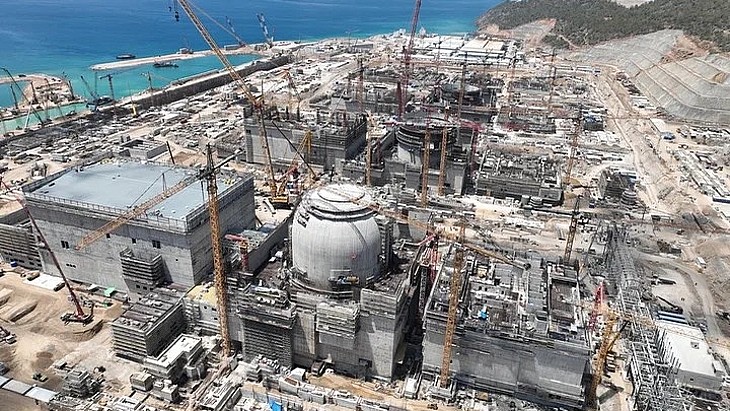
Thursday, 12 December 2024
14 Luxury Hotels Are Donating Outdated Furniture to Low-Income Families in Need

Thursday, 5 December 2024
The harsh process of becoming a K-pop star is opening to western performers
Made in Korea: The K-Pop Experience is a six-part reality show following five British trainees over 100 days as they debut as a Korean-pop (K-pop) idol boy group called Dear Alice. In collaboration with SM Entertainment, a K-pop powerhouse, the show will introduce the behind-the-scenes of making a K-pop idol through an immersive training system.
Showing a glimpse of the lives of K-pop trainees, the first episode introduces K-pop as a multi-billion global phenomenon, stating: “Six of the top 20 best-selling artists in the world were K-pop and 90 billion streams were by K-pop idols.”
K-pop is becoming increasingly popular in the UK. Girl group Aespa and boy group BTS have sold out shows in the country’s largest arenas.
In 2023, the group Blackpink became the first Korean band to headline a UK festival at BST Hyde Park, where they played to an audience of 65,000. They were also awarded honorary MBEs by the king for their role in encouraging young people to engage with the global UN climate change conference at COP26 in Glasgow 2021.
There is certainly an appetite for shows about K-pop for western audiences. Netflix have released their own version of Made in Korea, Pop Star Academy: Katseye.
The docuseries follows 20 girls from Japan, South Korea, Australia and the UK going through a year of K-pop training to become the group Kasteye. It’s a collaboration between the K-pop label Hybe and US label Geffen (a subsidiary of Universal).
Generally speaking, K-pop is characterised by catchy and lively melodies and highly choreographed dance routines in perfect unison and fancy outfits. Inspired by various pop music genres – including but not limited to electronic dance, hip hop, and R&B – the genre became distinctive from the nation’s traditional music, especially after a handful of pioneers began producing idol groups in the 1990s.
I’m South Korean and I’m studying cultural industries, so it’s interesting for me to see westernerss becoming K-pop-inspired idol groups. It’s a famously competitive industry, which is already oversaturated with hopeful K-idols. Considering that the domestic market is small and highly saturated, their success will be a breakthrough for SM Entertainment and HYBE, as well as other K-pop companies, proving whether they can continue to grow beyond east Asia.
The production and delivery of this popular music genre have become more international than ever in recent years, with hundreds of choreographers, composers and producers worldwide contribute to creating K-pop songs and performances. In contrast, K-pop performers have until recently been predominantly Korean. But as the new shows demonstrate, this too is changing.
K-pop companies have hosted auditions outside the country to recruit foreign trainees to make their idols appeal to global audiences. Huge global music corporations like Sony, Universal Music Group and Virgin Records have also got in on the game, signing distribution contracts with major K-pop idols to promote their music in foreign markets.
This search isn’t because there is a lack of willing hopefuls in Korea. There were around an estimated 800 trainees waiting to debut in 2022. But Korea’s population is only around 50 million and record companies want to appeal beyond the domestic market, so they are hoping recruiting non-Korean stars will help do that.
Music agencies in the west tend to find new artists who are already gifted and then largely serve as intermediaries arranging things like tours, marketing and artists’ wider schedules. However, major K-pop companies have developed a unique system of finding and launching new artists. This involves hosting auditions with a competition of at least 1,000 to 1 odds. The winners then undergo years of of acting, vocal, and dance training before debuting.
To make the vocals flawless and the dance moves precise, trainees, known as yeonseupsaeng (연습생), are expected to spend up to 17 hours per day practising performances and training for several years – although they aren’t guaranteed to become professional artists. Even if they do become successful, their private lives – including their dating lives – are strictly controlled.
It is no exaggeration to say that the industry is labour-intensive as well as capital-intensive, built on the blood, sweat and tears of yeonseupsaeng.
The first episode of Made in Korea ends with SM’s director Hee Jun Yoon’s critique of the Britons’ first performance. It’s difficult viewing for those unfamiliar with the harsh world of K-pop. To borrow the words of BBC’s unscripted content head, Kate Phillips, it makes “Simon Cowell look like Mary Poppins.”
Some might question the prefix “K-” being used to describe these international groups but the genre will remain decidedly Korean. It is Korean companies which will lead the production mechanisms and the domestic market will continue to serve as the testbed for new artists. But the success of Dear Alice and Katseye is important if the genre is to survive and continue to grow beyond Korea.

Looking for something good? Cut through the noise with a carefully curated selection of the latest releases, live events and exhibitions, straight to your inbox every fortnight, on Fridays. Sign up here.![]()
Taeyoung Kim, Lecturer in Communication and Media, Loughborough University
This article is republished from The Conversation under a Creative Commons license. Read the original article.
Monday, 2 September 2024
South Korea to conduct offensive cyber defence operations to protect national infrastructure from hacking attacks
Saturday, 13 July 2024
Contest Winner Turns Bridge into the Longest Walking Art Gallery in South Korea
Monday, 24 June 2024
S. Korea to develop LEO satellite communications system by 2030
Monday, 27 May 2024
S. Korea to develop LEO satellite communications system by 2030

Tuesday, 7 May 2024
S. Korea's working-age population to dip by nearly 10 mn by 2044 amid low births

Wednesday, 6 March 2024
Nuclear output to reach new record by 2025, says IEA

Monday, 16 October 2023
US court dismisses Westinghouse case against Korea : Corporate
.jpg?ext=.jpg) A rendering of two APR1400 units (Image: KHNP)
A rendering of two APR1400 units (Image: KHNP)Monday, 11 September 2023
Past Lives: a luxurious and lingering portrayal of lost love and identity in the Korean diaspora


Wednesday, 26 July 2023
Polish government approves first nuclear power plant : New Nuclear
.jpg?ext=.jpg)
Sunday, 29 January 2023
Samsung completes design of CMSR Power Barge : New Nuclear
.jpg?ext=.jpg)
The Power Barges are modular and can produce from 200-800 MW of electricity (Image: SHI/Seaborg)
Thursday, 23 June 2022
USA ,NATO Must need to provide, Nuclear weapons to Taiwan, Japan and South Korea to maintain world Defense balance
Thursday, 18 February 2021
Kim’s wife appears in public for first time in a year


Monday, 18 January 2021
Samsung chief Lee jailed for 2.5yrs over graft scandal

Saturday, 9 January 2021
US is North Korea’s ‘biggest enemy’: Kim

Friday, 8 January 2021
Kim admits North Korea’s economic plan failed

Tuesday, 5 January 2021
South Korea sees more deaths than births in 2020

Tuesday, 29 December 2020
S Korea tops in 10 most automated countries
Monday, 28 December 2020
Indian Army chief visits South Korea to enhance military ties
Indian Army Chief General Manoj Mukund Naravane is on a three-day visit to the Republic of Korea on Monday aimed to strengthen military ties between both the countries.







